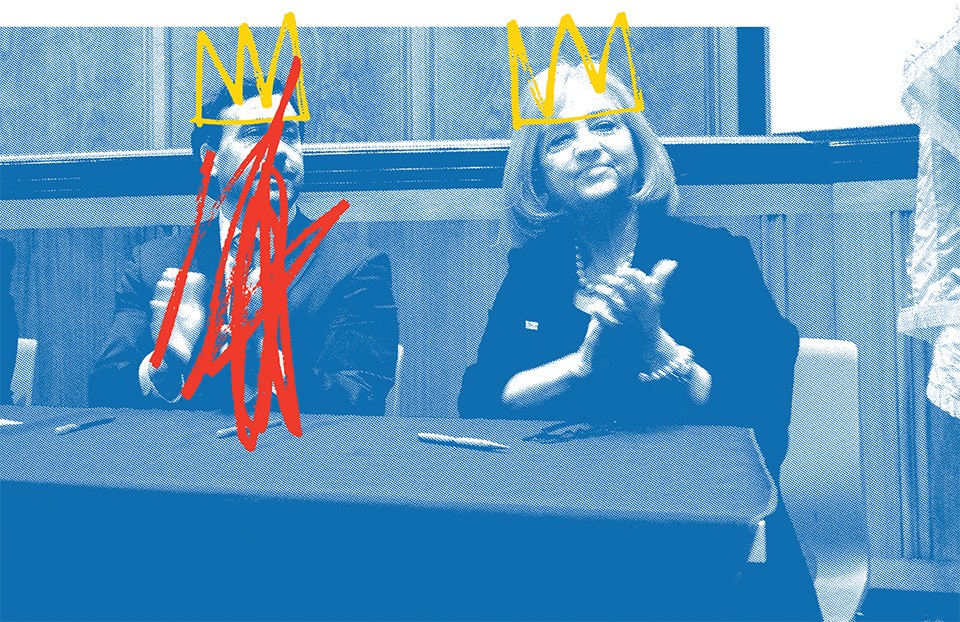
Government Reorganization Plan: Minority Rule
Better Together's proposed constitutional amendment is best understood as a framework, establishing the ground rules under which our new regional government will take shape. Section 2.7(c), which entrusts the formulation of what the report calls a "reorganization plan" to the individual serving as county executive on January 1, 2021 ("Metro City Mayor") and Mayor Lyda Krewson ("Transition Mayor"), is at the heart of the amendment's efforts to limit who gets a seat at the decision-making table. The plan would rewrite our government, superseding "charter provisions, ordinances, resolutions, rules, regulations and orders."
Some decisions are necessary in order to make unification real — consolidating departments, eliminating contradictions in city and county codes, and much more. But unlike today's charter amendments, these changes would not be subject to a public vote, or even the approval of the Metro Council, the new city's legislative body. In what may be the proposed amendment's most extraordinary language, it provides that the plan goes into effect unless it is rejected by a two-thirds vote of the new Metro Council.
This approach runs against our nation's most fundamental democratic principles. When such important issues are on the line, it is imperative that changes have clear popular support. Constitutional amendments do not go into effect unless they are approved by a two-thirds vote in Congress (and ratified by the states). The city's current charter goes even further, requiring a two-thirds vote of the people. Better Together's approach does the precise opposite. Instead of permitting a third of the legislature to obstruct change, it empowers a minority to impose a vision developed by just two elected officials, and bypasses a public vote altogether. The absence of real checks is especially problematic because much of the substantive work will be done by privately funded lawyers and consultants — making this precisely the time we need rigorous oversight.
It is also worrying that, for all the equitable rhetoric associated with the plan, the governing legal standards concern necessity and efficiency. Specifically, the amendment empowers the two executive officers to design the reorganization plan "as necessary and proper, to effectuate this section and to ensure the proper and efficient administration of the affairs of the metropolitan city." The "and" is important, as it means that changes to our laws implemented through this process do not have to be directly tied to the merger process, and may instead simply advance the new city's efficiency — deregulatory measures including a weakening of anti-discrimination laws could be passed under this provision. It is telling that the word "equity" appears just once in the legal text, in a section allowing the metropolitan mayor to appoint a deputy mayor focused on community engagement and equity.
Redrawing the Map: Unchecked Self-Dealing
The establishment of the new city's Metro Council, which would redraw the region's political map in the form of 33 council districts, is also fraught with potential for abuse. In any districting effort, the key questions are: Who gets to draw the lines, how are they selected, and how are they constrained. As others have noted, the proposed amendment raises concerns in each respect, but fails especially dramatically with respect to selection.
Flying in the face of best practices, which are designed to minimize self-dealing by affording a variety of conflicting stakeholders an opportunity to veto the selection of a demographer, section 2.(5)(c)(i) of the amendment confers complete appointment authority to the co-executives. For comparison, Clean Missouri, which was approved by Missouri voters in 2018, lays out a map-drawing process that charges the state auditor and Senate majority/minority leaders with jointly selecting a demographer, and subjects the resulting map to a committee selected jointly by the Republican and Democratic parties, as well as the governor. It's a convoluted process, but it's designed to minimize the abuse that emerges when one set of political interests is able to take over.
Conversely, under Better Together's plan, the only check on the map designed by the demographer lies in the current County Council and city Board of Aldermen, provided that they manage to agree to and pass identical plans. Setting aside the reality that this level of coordination could prove a challenge for occasionally dysfunctional legislative bodies, the fundamental problem is that this structure puts the status quo bias to work in favor of the interests of the co-executives. In fact, they could use this power to design a map that delivers a legislative body that affords them the one-third support they need to pass the government reorganization plan. Each legislative body can veto the other's effort to change the map, and like the reorganization plan, the new map goes into effect even if the legislative bodies do not approve it, meaning that wherever the County Council and Board of Aldermen disagree, the executives set the default outcome.
Politics: And You Thought "Aldergeddon" Was Bad
Thus far we have discussed the roles of metro city mayor and transition mayor in abstract terms. This is partly because Steve Stenger's political (and legal) troubles create substantial uncertainty about the identity of the metro city mayor, but also because this degree of concentrated power should worry us, regardless of who wields it.
For example, I respect Mayor Krewson's integrity. Like all administrations, however, her team is disproportionately connected to, and thus responsive to, her political base, which is disproportionately white and wealthy. The structure of city government balances those tendencies, imperfectly, with other voices in government who represent a diverse set of interests. Better Together's proposal both raises the democratic stakes — the design of a new city charter, new political map and the city's first budgets (more on this in a minute) — and eliminates checks. It extends Krewson's term to five and a half years, cuts the city's legislative branch out of the work of designing the new city and sidesteps a public vote on the city's new charter. This approach is unjustifiable. The new city should serve all communities equally, which means all communities must be represented in its design.
The potential for democratic failure was especially high when it looked like Stenger and Krewson would serve together as co-executives. Their overlapping constituencies made it unlikely that they would seriously check each other. In the wake of the news that Stenger's administration is the subject of a federal investigation, however, his removal is a real possibility, so it's worth turning to the question of who will serve as Mayor Krewson's partner through the transition.
There are three basic scenarios. First, Stenger could survive to serve as metro city mayor through 2022. The truth is that proving political corruption is not easy, and barring felony conviction, the County Council's authority to remove Stenger is limited. Instead, voters would need to submit an initiative petition to recall the county executive. The county charter sets the bar high for such an action, requiring 20 percent of the local votes in the last gubernatorial election: 100,000 signatures.
If, however, he is removed, the ball would be passed to the County Council to nominate a temporary successor from their own ranks. Because the new county executive is legally required to be a Democrat, it's likely that the Council's three Republican members would support Sam Page, the most conservative Democrat on the Council. If the recall question went to the voters in November 2020 on the same ballot as Better Together's proposal, that would leave Page as county executive on January 1, 2021, and thus, as metro city mayor. While Page may, like Krewson, operate in good faith, the fact remains that the co-executives will represent a narrow set of interests — in fact, the vast majority of the new city's voters will not have voted for either of them.
Finally, if Stenger was recalled in November 2019, or in the 2020 primary season, this would trigger an election for county executive that would unfold simultaneously with the state vote on Better Together. That prospect would likely draw a slew of candidates with a variety of positions on regional unification. While it is impossible to predict the outcome of such a race, the one thing that is clear is that it is a recipe for bad outcomes.
For example, given that Better Together does not expect the proposal to pass at the local level, it does not seem far-fetched to imagine that the county could elect a candidate dedicated to obstructing consolidation, plunging the new city into an unproductive political mess even as Better Together's proposal defunds government. Alternatively, a crowded primary could result in the election of a county executive with a small fraction of the vote, mirroring Mayor Krewson's election in 2017 with one-third of primary voters. The odds of inclusive representation among the co-executives seem slim at best. Conversely, the three scenarios outlined above point to serious risk that Better Together's unaccountable structure will be abused to elevate the interests of white wealthy St. Louisans in the design of the new city.
Municipalities: Separate and Unequal
Unfortunately, the catalog of anti-democratic provisions does not end here. The last big piece of this puzzle is how the new municipal structure will result in uneven distribution of power within the new Metro City. While the proposal preserves county municipalities, it affords them varying degrees of autonomy depending on the strength of their property and sales tax bases.
Sections 5.4(a) and 5.2(b)(ii) give municipalities within the new Metro City the authority to set their own property (and utility) tax rates, as well as control over how they choose to spend these revenues. This puts the budgets of municipalities with strong property tax bases (places like Ladue, Kirkwood and Webster Groves) largely out of reach of the new Metro City. Conversely, sections 5.4(b) and 5.2(b)(i) place municipalities that rely on other taxes under the control of the metropolitan government, though those with strong sales tax bases — that is to say, with malls — retain some autonomy, the extent of which will ultimately have to be settled through practice, or litigated. Finally, after 2022, the city of St. Louis itself would be dissolved into a municipal corporation, with its debt managed by a committee of five appointed individuals. At that point, city residents would rely solely on the Metro City to determine service levels.
This structure has various implications, including for airport privatization, which could possibly be carried out through the municipal corporation. For the purpose of this analysis, however, the most relevant piece is that while wealthy municipalities will control their municipal district budgets, insulating them from city-wide cuts, the areas that are currently St. Louis city, the unconsolidated county and poorer municipalities in north county will rely on a vote of the full 33-member Metro Council to set spending levels, making them more vulnerable to forced cuts. This system also affords Council members representing municipalities that are able to fund services through property taxes disproportionate leverage over their counterparts, who will need their votes on countless bills, but are excluded from the same decisions affecting their more affluent peers.
It's also worth highlighting that section 5.1(a) of the amendment prohibits redistribution in the provision of municipal services. Municipalities that are already under-funded will have no prospect of improving basic services for their residents unless they dissolve. Reducing the number of county municipalities is a good thing, but we should be uncomfortable with a world in which the only remaining municipalities are in wealthy, white parts of the county. Furthermore, because the proposal empowers municipalities to serve as local planning commissions, the dissolution of the city and poorer municipalities would result in an unequal level of local control over development across the new Metro City.
Fundamentally, the proposal would shift the locus of elected representation subtly, but powerfully, towards wealthier areas of St. Louis County, and erect a financial wall prohibiting the redistribution of property tax revenue among municipalities.






